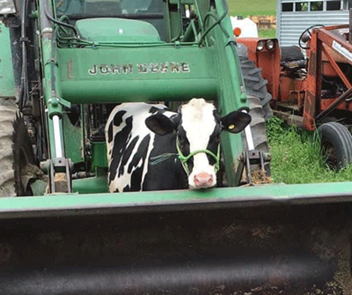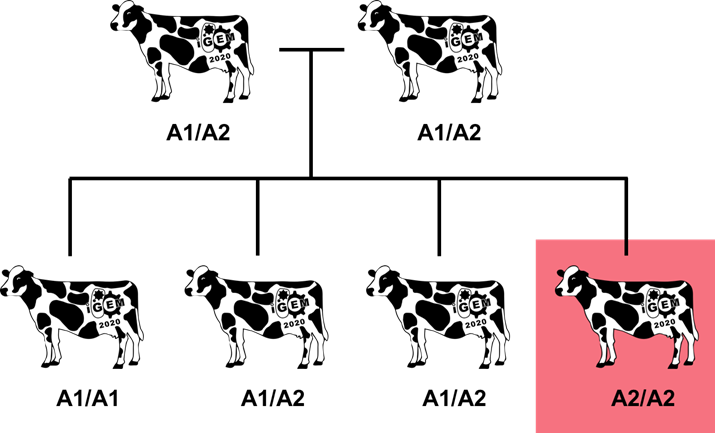
Confirming A2 Alleles via Luminescence in the Field
Our team decided that we wanted to work on a project that would have the potential to positively impact our local community. Our College is the State University of New York (SUNY) College at Oneonta, which is located in Oneonta, a small city in Otsego County, in rural central New York State. The county has a small population of about 60,000 people per 1,000 square miles. There are many small family-owned farms throughout the area.
Agriculture is important for Otsego County. The market value of all agricultural products sold by County farmers in 2012, the most recent year for which data are available, was over $66 million. In our county, there are roughly 661 people employed in agriculture, and their wages accounted for $5.5 million in 2012 (1).
There are many kinds of farms that can be found throughout Otsego County and New York, but for our project we decided to focus on dairy farms. New York stands at a rating of 4th in the country with milk production coming to 15.1 billion pounds a year (2). There are 3,880 dairy farms, with an average herd size of 162 cows per farm.

We had a remote interview with two Otsego County farmers to learn more about some of the challenges that local farmers face. During this interview, we learned that many farmers in the area are struggling to keep their business afloat. There are many reasons why farmers are struggling, but competition with factory farms, variable commodity pricing, high operational costs and the prevalence of middlemen all contribute. To remain profitable, farmers are employing different strategies, including changing the type of farming they conduct, selling directly to consumers via farmers’ markets or cooperatives, or selling specialty products that command a high price. One example of such a market in the United States, is the A2 milk market.
A2 Milk
Milk is composed primarily of water (88%), lactose sugar (5%) and protein (4%) (3). Beta-casein, one milk protein, makes up almost 30% of the protein content of milk (4). All breeds of cow used in the dairy industry produce one of two variants of β-casein, A1 or A2 (5,6). These two alleles are created by a single nucleotide polymorphism (SNP) in the β-casein gene (CSN2) (Figure 1). This SNP creates an amino acid polymorphism in the A1 and A2 β-casein protein at position 67, in which A1 β-casein has a histidine and A2 has a proline (7). The presence of a histidine at position 67 in A1 β-casein leaves it susceptible to proteolytic cleavage; A2 β-casein is not. Proteolysis of A1 β-casein can yield a variety of peptides, including β-casomorphin 7 (BCM7) which belongs to a group of peptides which may have opioid properties (8).

Figure 1. CSN2 alleles and the impact of the A1/A2 SNP.
Some studies have suggested that BCM7 may have negative health effects. Consumption of BCM7 has been linked to a variety of health conditions including type I diabetes, heart disease, and interference with normal gastrointestinal function (9,10). Recent work suggests that many individuals with presumed lactose intolerance may in-fact be sensitive to A1 beta-casein and BCM7 (11).
Production of A2 milk is a rapidly growing niche market
Because of the reported health benefits, many consumers are making the switch to A2 milk. A2 milk is very common in New Zealand, Australia, and China, yet the A2 market in the US is just beginning to expand (5). In fiscal year 2020, The A2 Milk™ company reported that US market sales amounted to $66.1 million dollars, representing a 91% increase in the previous year’s sales (12). The North American market is estimated to exceed 4,759 600 million dollars by 2025 (13).
In the US, the most common breeds of dairy cattle represent different β-casein lineages, Guernsey cows are mostly homozygous for A2 CSN2, while Holstein Friesian are mostly homozygous for A1 CSN2. The Holstein and Jersey breeds (the most common dairy cow breeds the United States) are usually heterozygous for the two alleles (14). Only cows that are homozygous for the A2 allele of CSN2 can make A2 milk. This means that, to make A2 milk-producing herds, it is necessary to identify cows that carry the A2 gene, and to breed them, to create offspring which contain only the A2 gene (Figure 2). While genetic testing can be done to determine a cow’s “A status”, it is time consuming and expensive, and may take weeks to yield results.

Figure 2. An example breeding scheme in which two heterozygotes have a 25% chance of yielding an A2 homozygote offspring.
Ca2LF is born
We were inspired to use synthetic biology to create a detection system that can be used to rapidly detect the “A status” of cattle. We wanted to make it easier for local farmers to enter this emerging market, so they could sell their milk for a premium price and increase their profit margins. We wanted our detector to be field-deployable, so that dairy farmers can test their cattle themselves. This eliminates the cost of laboratory testing, shipping out samples to these laboratories, and increases in convenience. The ideal field test is simple and easy to use without a laboratory and will yield results in a matter of hours, rather than days or weeks!
References
- Final Agriculture and Farmland Protection Plan. Otsego County Board of Representatives. Resolution number #264-20170906. September 6, 2017. https://www.otsegocounty.com/Document%20Center/N-R/Planning/AGRICULTURE%20DISTRICT%20REVIEW/7.FINALAGFARMLANDPROTECTIONIPLAN.pdf
- New York Agriculture. (n.d.). Retrieved October 24, 2020, from https://www.nyfb.org/about/about-ny-ag
- Milk Facts. (n.d.). Retrieved October 24, 2020, from http://www.milkfacts.info/Milk Composition/Milk Composition Page.htm
- Kamiński, S., Cieslińska, A., & Kostyra, E. (2007). Polymorphism of bovine beta-casein and its potential effect on human health. Journal of applied genetics, 48(3), 189–198. https://doi.org/10.1007/BF03195213
- Caroli, A. M., Chessa, S., & Erhardt, G. J. (2009). Invited review: milk protein polymorphisms in cattle: effect on animal breeding and human nutrition. Journal of dairy science, 92(11), 5335–5352. https://doi.org/10.3168/jds.2009-2461
- Martin, P., Szymanowska, M., Zwierzchowski, L., & Leroux, C. (2002). The impact of genetic polymorphisms on the protein composition of ruminant milks. Reproduction Nutrition Development,42(5), 433-459. doi:10.1051/rnd:2002036
- Brooke-Taylor, S., Dwyer, K., Woodford, K., & Kost, N. (2017). Systematic Review of the Gastrointestinal Effects of A1 Compared with A2 β-Casein. Advances in Nutrition: An International Review Journal,8(5), 739-748. doi:10.3945/an.116.013953
- Jinsmaa, Y., & Yoshikawa, M. (1999). Enzymatic release of neocasomorphin and β-casomorphin from bovine β-casein. Peptides,20(8), 957-962. doi:10.1016/s0196-9781(99)00088-1
- Nguyen, D. D., Johnson, S. K., Busetti, F., & Solah, V. A. (2014). Formation and Degradation of Beta-casomorphins in Dairy Processing. Critical Reviews in Food Science and Nutrition,55(14), 1955-1967. doi:10.1080/10408398.2012.740102
- Jianqin, S., Leiming, X., Lu, X., Yelland, G. W., Ni, J., & Clarke, A. J. (2015). Effects of milk containing only A2 beta casein versus milk containing both A1 and A2 beta casein proteins on gastrointestinal physiology, symptoms of discomfort, and cognitive behavior of people with self-reported intolerance to traditional cows’ milk. Nutrition Journal,15(1). doi:10.1186/s12937-016-0147-z
- Pal, S., Woodford, K., Kukuljan, S., & Ho, S. (2015). Milk Intolerance, Beta-Casein and Lactose. Nutrients,7(9), 7285-7297. doi:10.3390/nu7095339
- Annual reports and financial results. (n.d.). Retrieved October 24, 2020, from https://thea2milkcompany.com/results/
- A2 Milk Market Size, Share, Industry Demand, Global Analysis, 2025: MRFR. (n.d.). Retrieved October 24, 2020, from https://www.marketresearchfuture.com/reports/a2-milk-market-6495
- Pasin, G., & Pasin, G. (2017, February 09). A2 Milk Facts. Retrieved October 24, 2020, from http://cdrf.org/2017/02/09/a2-milk-facts/


